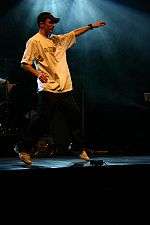Robot (dance)
| Part of the series on Popping |
 |
| Related styles |
|---|
|
| See also |
| view |
The robot (or mannequin) is an illusionary street dance style – often confused with popping – that attempts to imitate a dancing robot or mannequin. Roboting gained fame after Michael Jackson used the dance when he performed "Dancing Machine" with his brothers,[1] and later performed the dance during his solo career in songs such as "Billie Jean".
Description
The robot was created in 1967. It is a dance in which the dancer moves their limbs in a way that imitates the movements of a robot. Movements of the robot are normally started and finished with a dimestop (a very abrupt stop), to give the impression of motors starting and stopping, but poppers have also been known to do the robot with a pop to the beat. As long as the illusion of being a robot is maintained, it is considered the robot.
Robot dancing is often considered a subsection of popping because poppers often include the robot in their routines, sometimes adding pops to the beat while maintaining the illusion of a robot, but the robot also exists as its own dance and is sometimes considered a performance rather than a dance when the performer is imitating a robot without any music. When done without music it is considered to be mime, instead of dance. Street theater often featured mimes who did a mechanical man or puppet style illusion, without music. In the late 1960s, the style was used while social dancing to funk or soul music. Charles "Robot" Washington[2] was not the first to strictly imitate a robot as a mime, however he and his partner "Robot Ann" were the first to socially couple dance the style to music at parties and clubs, and it was at this point it became a party dance and later combined with other illusion styles to form today's popping style. It is commonly known as "Robotics". Roboting has also been likened to the jazz-era folk dance of puppeting (a style also appreciated in some colors of experimental ballet), whereby the dancer would emulate the mechanical movements of a simple musical box doll.
Music
As with popping in general, and the visual impact of the robot can be boosted by doing it in pace with music. The best effect is achieved with music that has very distinct beats such as electrofunk. It is nonetheless common to use music not particularly suited for the dance, but which has a "robot theme", In 1969 Jack Wild in the Mechanical Boy episode of H.R. Puffnstuff, or The Jackson 5's "Dancing Machine" Robot done by Michael Jackson. The Jackson 5 first performed Dancing Machine on Soul Train in later October 1973 where Michael Jackson performed a robot dance during the song's musical break. The group again performed the routine on The Mike Douglas Show and the Sonny and Cher Comedy Hour in 1974.[3][4]
Unlike most other dances, the robot may also be accompanied a cappella by making vocal impressions of beeps or boops and other electro-mechanical sounds.
World record
On September 29, 2009, the Guinness World Record for the Largest Robot Dance was attempted by Robogals at the University of Melbourne, Australia. The previous record of 276 was broken when a Guinness World Record recognised 318 people were recorded as dancing in unison in approved robot style.[5]
References
- ↑ Mansour, David. From Abba to Zoom: A Pop Culture Encyclopedia of the Late 20th Century, p. 403 (2005) ("The Robot was a mimelike dance, popularized by The Jackson 5 and their Top Ten hit "Dancing Machine" (1974)")
- ↑ Hip-Hop and Urban Dance, p. 17 (2009)
- ↑ Lehman, Christopher P. A Critical History of Soul Train on Television, p. 84 (2008)
- ↑ McMillian, Stephen (22 October 2013). Soul Train History Book Presents: Michael Jackson Debuts the Robot, SoulTrain.com
- ↑ "Students in robot dancing record attempt". Australian Broadcasting Corporation. September 29, 2009. Retrieved May 20, 2013.
External links
- James Brown Doing the Robot Dance in a '70s video.
- A 1970 James Brown performance on the TV show Soul Train features a female dancer, Damita Jo Freeman, performing The Robot.
[[Category:Popping (dance)